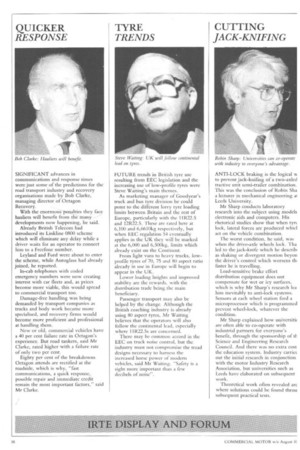CUTTING JACK-KNIFING
Page 20

If you've noticed an error in this article please click here to report it so we can fix it.
ANTI-LOCK braking is the logical w to prevent jack-knifing of a two-axled tractive unit semi-trailer combination. This was the conclusion of Robin Sha a lecturer in mechanical engineering ai Leeds University.
Mr Sharp conducts laboratory research into the subject using models electronic aids and computers. His rhetorical studies show that when tyre lock, lateral forces are produced whicl act on the vehicle combination.
The worst condition, he said, was when the drive-axle wheels lock. Tha led to the jack-knife which he describ, as shaking or divergent motion beyon the driver's control which worsens th, faster he is travelling.
Load-sensitive brake effort distribution equipment does not compensate for wet or icy surfaces, which is why Mr Sharp's research lea. him inevitably to anti-lock systems. Sensors at each wheel station feed a microprocessor which is programmed prevent wheel-lock, whatever the condition.
Mr Sharp explained how universitic are often able to co-operate with industrial partners for everyone's benefit, through the sponsorship of th Science and Engineering Research Council. And there was no extra cost the education system. Industry carriec out the initial research in conjunction with the motor Industry Research Association, but universities such as Leeds have elaborated on subsequent work.
Theoretical work often revealed are where solutions could be found throu subsequent practical tests.




































































